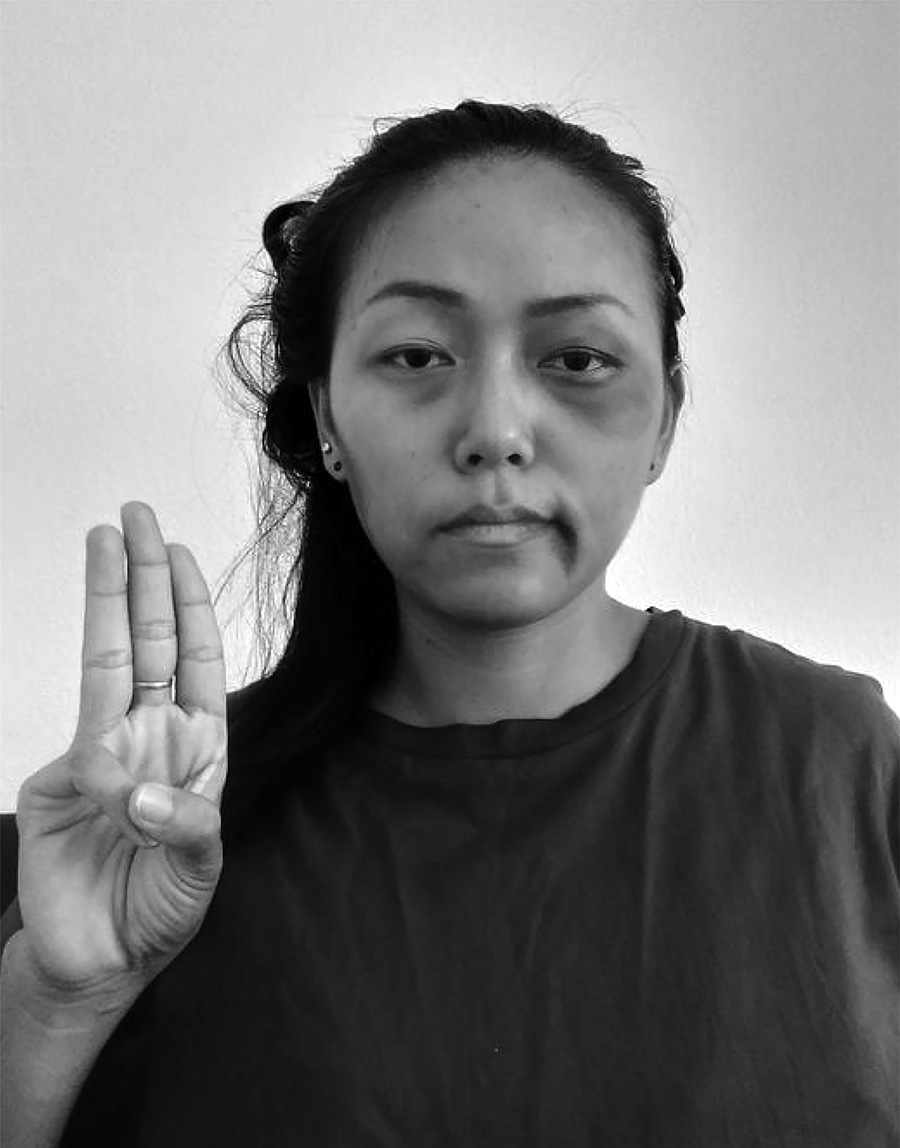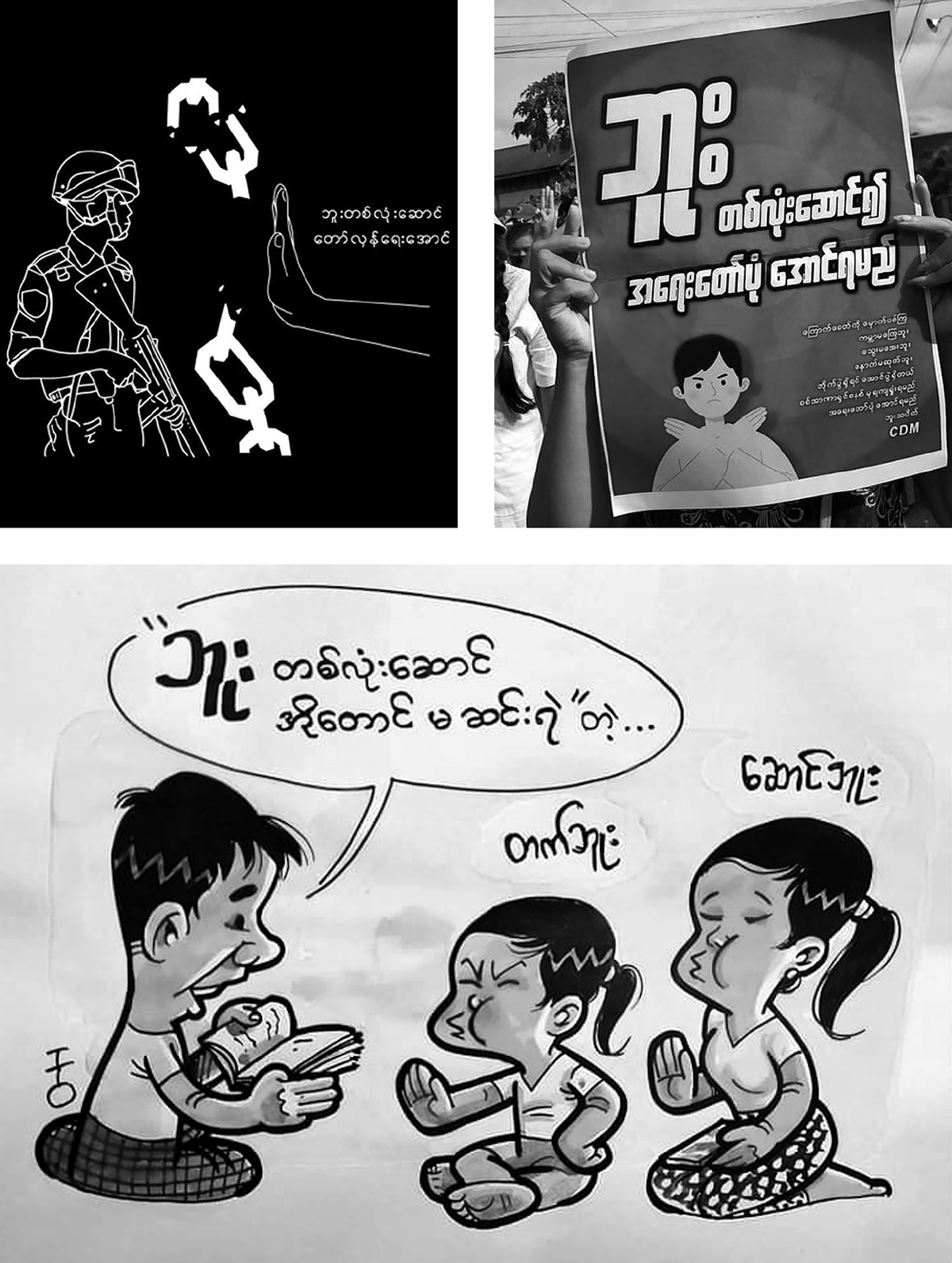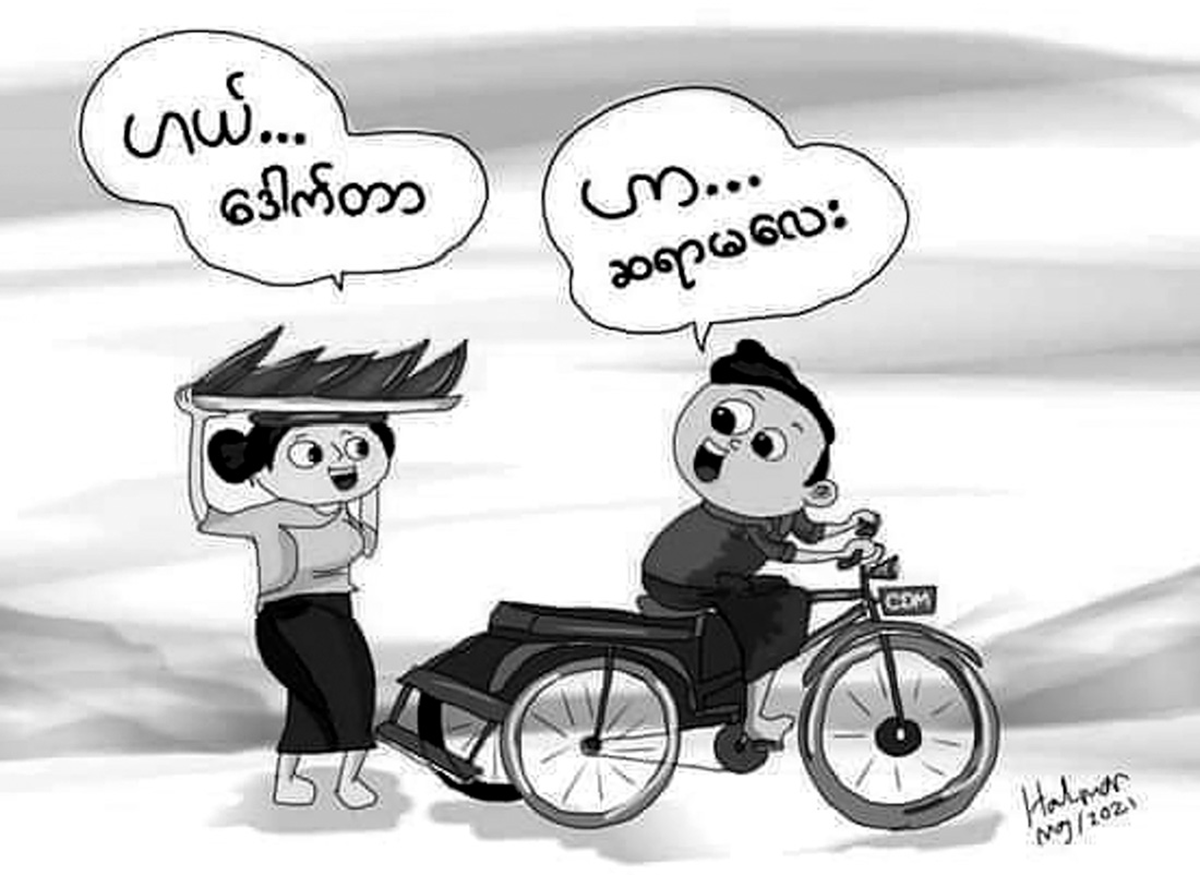The dogs nearly got us.
IT WAS APRIL 16, 2021, nearly three months into the uprising against Myanmar’s military coup. During this period, Burma’s masses had organized a Civil Disobedience Movement (CDM) against the country’s armed forces. Mass protests had become a revolution and civil war. I had been in daily contact with Ko Taw, a grassroots political activist and my long-term interlocutor and friend with whom I worked and traveled extensively during fieldwork in Myanmar in 2014 and 2015. In periodic live streams and chat bursts in the two months since the February 1 coup, he and his comrades had been relaying details from the early days of their participation in the CDM, when their tentative sticker and pamphlet campaigns encouraging collective action gave way to massive protests and general strikes that effectively collapsed the state’s normal functioning. But then came a brutal crackdown by the “dogs”—the ubiquitous term for both military generals organized under the newly formed State Administrative Council (SAC) and the ground-level police and soldiers. The dogs terrorized the country, having murdered by that point more than 750 people (including forty children),1 maimed unarmed protesters, sexually assaulted imprisoned activists, shot at random into houses, destroyed cars, looted shops, and robbed citizens and even Buddhist temples for cash.
Ko Taw and the crew at the Community Development Institute (CDI),2 their activist group, had reported on the pitched battles in the streets, the occupation of local governance institutions in peri-urban Yangon, and the arrest of members of their group. They described distributing funds smuggled into the country and extinguishing fires set by arsonists. They marveled at the courage of their countrymen and -women. But a week earlier Ko Taw’s number had gone silent, text messages returning only red exclamation points.
On that day in mid-April, a “Hi” text suddenly arrived from an unknown number. And then, “It’s Ko Taw.” He went on to say, “We (Thu Myat, Teza, and Mya and me) were being checked on the way to the hide house. But the dogs didn’t know who we really are. We pretended we were drunkards and there were two alcohol bottles we took for our cover story. They urged us to share one bottle with them. Ha-ha.” Then, a pause. “But I think we can’t hide for a long time. It has become hard to continue our activities—there are many explosions in many places. We have to go to the border (Liberated Area). Some of our members have already got there. They are now working and fighting together with EAOs [Ethnic Armed Organizations].”
Quitting the city was an agonizing choice. Both Teza and Ko Taw would leave behind young children who would wonder why their fathers were no longer there. “He won’t understand why I discard him,” Ko Taw said about his younger son. Ko Taw relayed how his wife had phoned him with a warning: “She will never forgive me if I die from this. She said she will beat my dead body severely.” For the young members of their group, such as Thu Myat and Mya, the spatial rupture of going from city to jungle was an acknowledgment that the futures they had been expecting just three months earlier had vanished. Beyond this, they all felt that leaving was akin to throwing the city to the dogs: while recognizing the increasing futility of urban resistance, they felt like they were abandoning the people forced to continue life there. We connected briefly over video. Ko Taw panned over to Thu Myat and Mya, who smiled wearily. In the grainy rendering of their faces illuminated by the glare of the neon ceiling light, they looked much older than I remembered.
Rights Refused is an ethnography of these political activists’ lives, attending to spaces such as the “hide house” and to the kinds of decisions debated and made there—when to protest, when to flee, how to mobilize others, how to withstand violence—that are then materialized on the streets, along paddy fields, in industrial zones, and eventually within jungle bases. It is based on eighteen months of in-country ethnographic fieldwork between 2014 and 2018 in which I worked, traveled, and periodically lived with this group of activists. I tracked how they advocated for workers and peasants across Burma during its time of so-called democratic transition, a period of massive, rapid political and economic change that was unceremoniously derailed by the 2021 coup, the aftermath of which I traced during a yearlong period of intensive digital ethnography following the military’s seizure of power. The book has two main purposes: (1) investigating how activist practices constituted by what I will differentiate as tactics of resistance within longer-term strategies of refusal reveal a particularly novel form of postcolonial governmentality extant in Myanmar—helping to explain this inexplicable coup—and (2) providing insights into how people maneuvering against semiauthoritarian oppression generate and utilize unique perspectives on rights.
That moment in April 2021, as CDI members pondered leaving Yangon, felt like an inflection point. It seemed that a fundamental alteration of tactics had become necessary, that resistance was giving way to something else. Until this point—since the first quiet postcoup days had exploded into millions of demonstrators taking the streets, staging transgressive protests that rejected not just the generals but also the desire of those generals to monopolize the symbolic sphere (more on this in chapter 4)—setbacks and challenges had been met with courageous responses. When the regime seemed an implacable monolith, early defections by soldiers and bureaucrats made victory appear possible. Myanmar’s ambassador to the UN inspired millions when, in a live speech in front of the General Assembly, he broke from the regime and delivered, his voice cracking as he broke into Burmese, the imperative to victory: “Ayay-daw-boun aung-ya-myee” (The revolution must be achieved).3 When recruiting additional members to join the CDM had seemed to stall, various protests sabotaged public infrastructure. These acts prevented people from going to work, lending additional thousands the plausible deniability necessary to join the strike (more on this in chapter 3). When the first major violent crackdowns soon thereafter might have marked the dampening of demonstrations, protesters responded by bearing their own scarred and abused bodies in defiance, undercutting the regime’s use of terror (more on this in chapter 1). When the concomitant collapse of the economy threatened to make continued resistance impossible for people who needed food to survive, networks of sharing emerged, diaspora remittance networks blossomed, and the taking of local government offices made distribution achievable (more on this in chapter 2). When the SAC tried to install its own government, the CDM enacted several substantive (albeit flawed) institutional improvisations, forming a parallel representative system called the CRPH that became in turn the National Unity Government (NUG). And when the Sit-tat4 tried to court ethnic Burmese subjects into its regime, CDM members demanded that its elite representatives publicly self-examine and apologize for the failures of the implicit Bamar chauvinism that characterized the earlier democratic transition period (more on this in chapter 6).
Yet while the CDM had overcome each challenge, winning such battles nevertheless led simultaneously to a sinking feeling that the war was being lost: activists fleeing to the border meant they were no longer “keeping the streets” (Aung 2021). The protests had dwindled to flash mobs that vanished moments after materializing and which were pushed to the outskirts of Yangon, peri-urban areas known as the hsin-kyay-boun.5 The SAC’s leader, Min Aung Hlaing, and not the NUG, was invited to an Association of Southeast Asian Nations (ASEAN) peace summit in late April. Days later, the SAC attempted to normalize its abnormality, announcing the reopening of schools, banks, and local governance institutions that the CDM had shut down or appropriated. There was a creeping suspicion that the regime had absorbed the best the CDM had to muster, that through intimidation and indoctrination (Rio 2021), it had kept its ranks from breaking.
But even as the crew prepared to retreat to the hills, where they planned to join thousands to train for an imminent return, yet another activist campaign began to circulate on Burmese Facebook. Called the buu—or “no”—campaign, it deviated from earlier ones in an important sense. The litany of creative protests up to that point had seemed to escalate in semiotic density—going from the barely discernible moan of the banging pots (referenced in the preface) to the emphatic images of bodies brutalized in resistance. This acceleration betrayed a realization that the movement required not just reiteration but intensification of energy for it to persist. In fact, a campaign called #Sisters2Sisters, led by activist Thinzar Shunlei Yi, simulated the bludgeoned faces of female comrades, thereby risking accusations of fakery and inauthenticity as the cost of magnifying and circulating the arresting reality they represented (fig. I.1).6
The buu campaign, by contrast, was relatively subdued. Organized around the negating particle “buu,” it articulated a simple and stark “no” to the coup, its slogan being, “If you carry a ‘no,’ the revolution must be achieved.”
While the slogan’s independent clause reiterated the CDM’s refrain (“The revolution must be achieved”), the initial clause, about carrying a “no,” invoked a Burmese proverb. Repeated in full by the male father figure in the cartoon in figure I.2, it reads, “Buu-ta-loun-saung oh-taung ma-sin-yeh” (If you carry a “no,” you will not be poor even when you are old).7 The verb saung has two simultaneous meanings here, “to carry” but also “to ward off evil.” And so carrying a “no” speaks to an imperative to constantly reject entanglement with others and their projects, to brandish “no” like a talisman to preempt even the consideration of an affirmative “yes.” Rejection, denial, and refusal—according to the proverb—are the only ways to guarantee self-preservation in the daily precarity and violence that have long characterized life in Myanmar.

Given this foreclosure of the embrace of human sociality and the political transformation it might bring, the proverb is often considered cynical. It could stand as an emblem of what Ardeth Thawnghmung, in her recent book on daily Burmese survival (2019), describes as the destructive coping strategies on which many of Myanmar’s poor are compelled to rely. Such strategies may assist individuals in the short-term, but by undermining collaborative action, they are deeply damaging to collective cooperation and survival over longer time frames.
Conversely then, by rejecting this classic injunction to turn inward, the buu campaign appropriated and resignified the “no,” suturing negation to a wholly different end: the revolution’s victory. Hence, the campaign transmuted a self-defeating imperative to self-preservation into one for solidarity. The images in figure I.2 indexing the coup hence stand as “counter-negations,” as historian Phyo Win Latt put it (pers. comm., October 8, 2021). Ko Taw concurred with this sentiment, saying, “The proverb means ‘no joining’ and ‘no participation.’ You should live alone. By this way no one can harm you. But it is just intended for individuals; the protest has another meaning. The protest is for the community” [Eng].

The CDM translated the demand into multiple rejections of any and all aspects of the new normal the SAC was trying to install. “The buu strike intends to choke the administration of the dogs [through] inclusive and continuous participation against the dogs. It also encourages the community and makes sense that we disobey the dogs’ orders,” Ko Taw asserted. As an April 2021 CDM tweet elaborated, “The ‘NO’ Strike: every #Myanmar can participate; - NO to paying taxes/bills - NO to businesses owned/affiliated by Junta - NO to #SAC’s rules & regulations - NO to ‘back to school, work, normal’; - NO to cash flow to #SAC; No one rules if no one obeys.” This “no,” however, yielded tragic acts of self-sacrifice. On August 11, 2021, a group of rebel youth hurled themselves from a four-story building rather than surrender to pursuing soldiers; it was believed that they chose group suicide—they held hands as they fell (Coconuts Yangon 2021)—so as not to betray comrades under ensuing interrogation (Irrawaddy 2021). More banal acts of sacrifice were precipitated by a public health infrastructure in revolt. A cancer patient, suddenly denied treatment by the absence of doctors, declared the following a week before his death: “I know I’m dying. But I will never blame the doctors, because young people are dying in the street after being shot by the police and soldiers. Compared to them, my death will be nothing” (Paddock 2021). This sentiment extended to the masses who chose to reject COVID-19 vaccinations delivered by SAC. The head of UNICEF in Myanmar was reported as averring that in her over two decades of work “in hot spots around the world,” “she had never seen people so hostile to the authorities that they would refuse health care that they needed.”
But just as importantly, such noes were also coupled with multiple yeses, as illustrated in figure I.3. In the cartoon, a woman calls out, “Hey Doctor,” to a passing trishaw driver (whose vehicle is adorned with the CDM label); he responds with “Ha, Teacher!” They have left their offices (persisting in the general strike) but remain active as part of the social infrastructure, providing food and transport as part of CDM’s mutual-aid support (Thawnghmung, Su Mon Thazin, Moo Moo Paw, and Boughton, forthcoming). Veteran Burmese writer Ma Thida (2022) renders the affirmative effervescence in the present tense: “Young doctors and nurses eat lunch from anonymous donors on the street while waiting for anyone who needs medical care. Some street boys and girls are enjoying a variety of free meals and drinks. . . . Rich people politely collect rubbish from poor protesters and they appreciate each other’s roles” (29).

The buu movement marked a reinvestment in popular opposition—after all, “every #Myanmar [person] can participate,” as the earlier tweet put it. It displaced the centrality of direct challenges in the streets to recenter a diffuse and all-encompassing rejection of military rule always present in the CDM. But it went further. By resignifying the parable’s original atomizing negation—where buu was a rejection of everything, even hope in something better—it encouraged connection and collaboration. The buu campaign thus evoked social theories, such as Tina Campt’s, that stress the generativity of negation (2019, 25) and its ability to create new political possibilities (see also Hartman 2018, 470).
Simultaneously, however, the buu protest’s original referent—the cynical parable—was not obliterated; buu could not so easily be irrevocably reformulated. Instead, the parable lurked as the condition that would reemerge if the revolution collapsed—or that would reemerge to collapse the revolution. It stood as an ever-present reminder of the fine line separating “no” as rejection of power’s prerogatives and “no” as rejection of solidarity and collaboration. As such, the buu distills the challenges of activism in a place such as Myanmar. Contentious action is necessary to beckon masses, who have been habituated to pursue self-preservation to the point of pathology, to see their conditions differently. The “no” must be robust and public enough to interpellate them. Yet direct resistance to the state will court annihilation (Shah 2021, 78). The “no” must be calibrated and strategic enough to not be suicidal. How can activism operate within such a perilous milieu, and how can its specific operations be understood?
1. The indispensable Assistance Association for Political Prisoners keeps a macabre running tally at https://aappb.org/coup. At the time this book went to print, the number was 3,171.
2. The group has had a number of names, and its activists have typically participated in multiple groups and networks. “CDI” will act as the proxy for these various names. All activist names are pseudonyms.
3. 
4. While Myanmar’s military refers to itself as the Tatmadaw  using a royal register (daw,
using a royal register (daw,  Burmese people largely eschew the term, especially given the honorific. They refer to it instead as the Sit-tat
Burmese people largely eschew the term, especially given the honorific. They refer to it instead as the Sit-tat  —a simple descriptor of an organization of violence, a military. This use also contains a “metapragmatic attack” (Jacquemet 1994) on the military by denying them the respected name they desire. The book will follow this vernacular usage
—a simple descriptor of an organization of violence, a military. This use also contains a “metapragmatic attack” (Jacquemet 1994) on the military by denying them the respected name they desire. The book will follow this vernacular usage
5. 
6. For a longer discussion of these dynamics, see Prasse-Freeman (2023a).
7. 